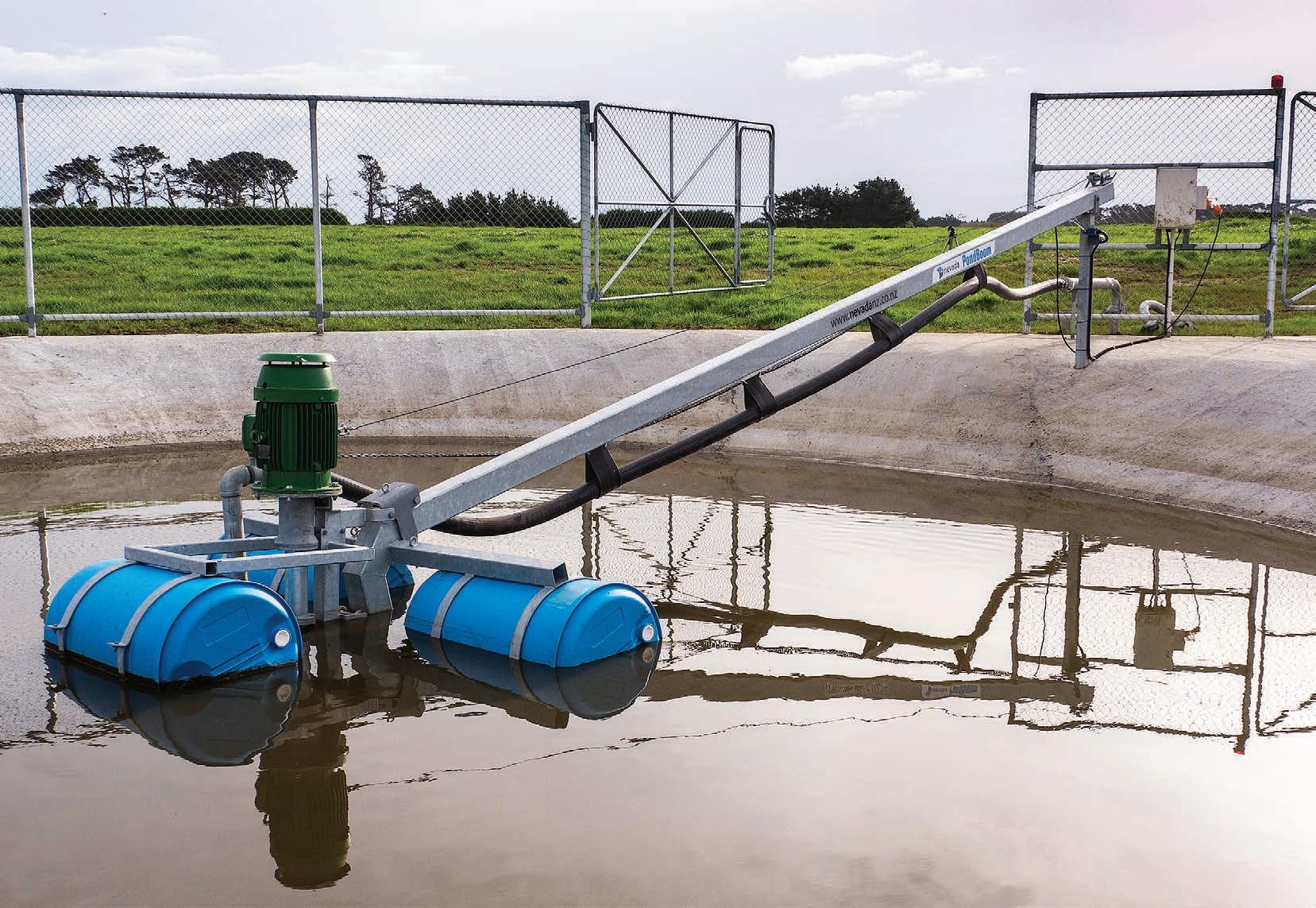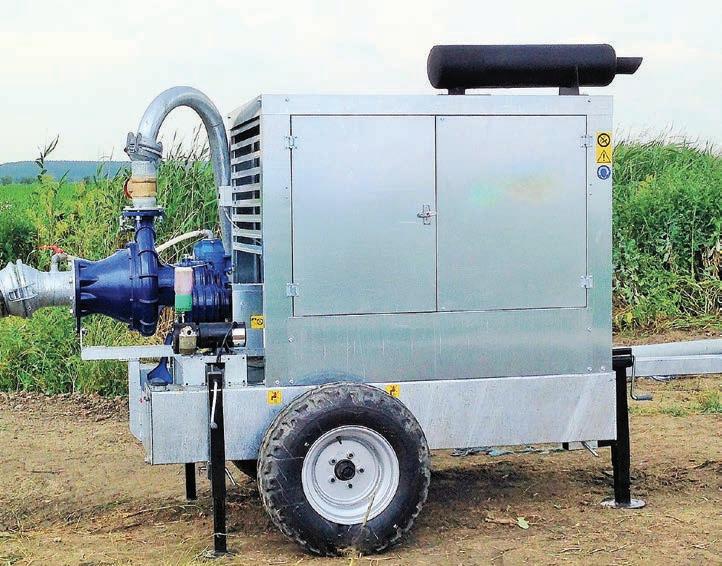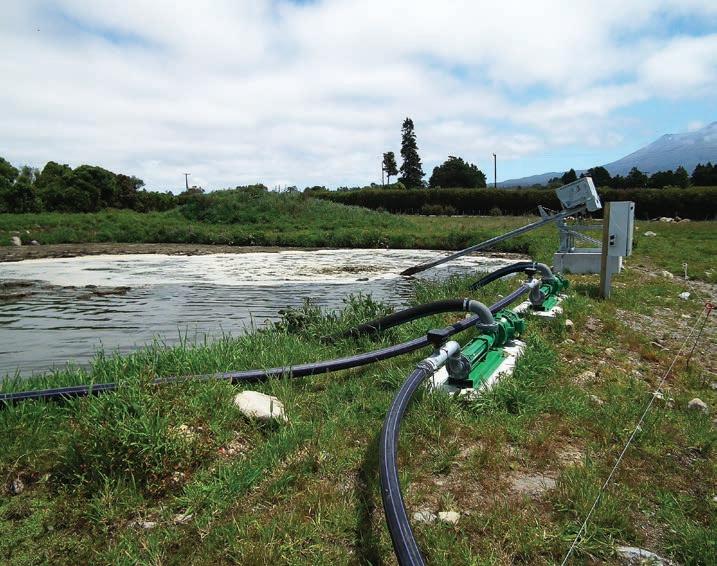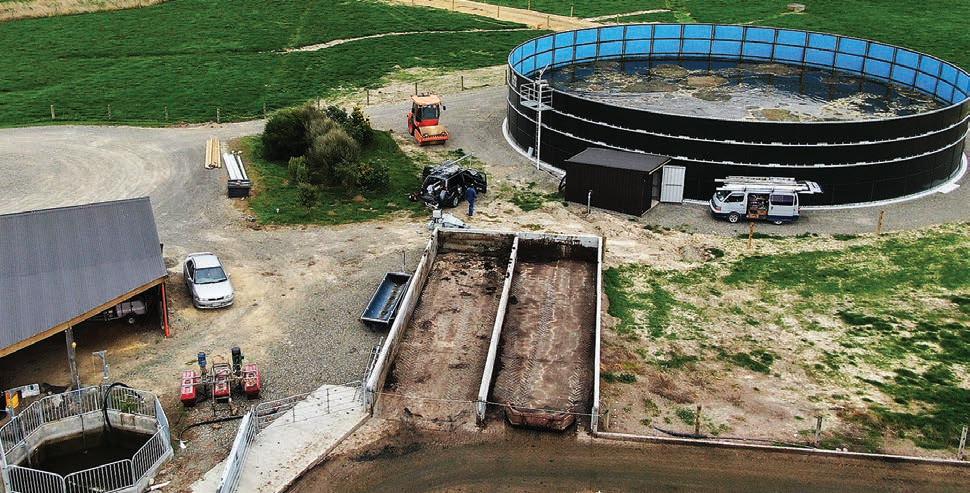
11 minute read
Effluent
by AgriHQ
It’s all about the pump
A PondBoom is recommended for floating centrifugal pump setups so that the pump can be safely brought to shore for maintenance without the need to enter the pond.
By Michael Prestidge Nevada effluent management specialist
Your choice of effluent pump can make or break the functioning of your effluent system. With a lot of pumps to choose from, and manufacturing improvements, we’re often called for advice on which pump is going to be best to get the job done. So, here’s what we recommend.
When electric is best
Electric pumps are our first recommendation if your pump is just servicing the one effluent pond/ tank, and you’re able to get electricity running down to the storage area. We recommend electric pumps because they are easy to automate and have much lower running costs than diesel and PTO pumps. They also provide a good flow in the range of 18,000 to 36,000 litres per hour, ideal for in-ground systems with most effluent irrigators.
The two most common types of electric effluent pumps are floating centrifugal and shore-mounted progressive cavity (PC) pumps. Where centrifugal pumps were once the go-to option, recent improvements to the geometry and quality of PC pumps has made them the preferred choice for safety, reliability and consistency.
A good quality progressive cavity effluent pump will provide a consistent flow of effluent to the irrigator regardless of where it is situated on the farm. Dairy farmers who’ve installed PC pumps confirm the output is the same whether they are pumping short or long distance, over flat or elevated land. PC pumps have a low horsepower requirement making them more efficient to run. They are also less expensive to install and are self-priming when set up correctly. Being shore-mounted they are the best choice for safety and maintenance as there is no need to enter the pond.
Centrifugal pumps are still a good option, however, compared with a good progressive cavity pump they require a higher power input and more control mechanisms to achieve the same level of consistency. While reliable, as they require more complicated mechanics there is a higher risk of complications. In terms of safety, centrifugal pumps can be shore mounted, but will require some form of priming. Alternatively, a PondBoom™ is recommended for floating centrifugal pump setups, so that the pump can be safely brought to shore for maintenance without the need to enter the pond.
PTO and diesel-powered effluent pumps
A well-chosen PTO or diesel-powered effluent pump will deliver high volume and high pressure ideal for use with multiple irrigators or drag hose type systems. Since they are portable and don’t require electricity to run, they’re

A well-chosen PTO or diesel-powered effluent pump will deliver high volume and high-pressure ideal for use with multiple irrigators or drag hose-type systems. Farmers should ensure they install a pump that has the correct pressure and volume to suit their farm.

ideal for use over multiple ponds or if an electric pump is not an option.
Smaller PTO pumps are usually recommended for small to medium farms where an electric pump is not an option. Large diesel-powered pump kits are often required for large, multi-pond farms and contractors where high output is desired. These large diesel pump kits can deliver 10 times the output of an electric pump.
It is important to note when selecting a pump that high horsepower does not equal high pressure. Effluent pumps must be both high pressure and high volume to be able to reliably pump effluent through a pipeline. It is always recommended to check with a specialist to make sure the pump you choose will have the correct pressure and volume to suit your requirements. n
Paul’s Cutting Back On Synthetic Ferts
On the outskirts of Nelson Lakes lies Paul Bavin’s 187ha dairy farm. Milking 640 cows, Paul pumps the effluent from a sump into an above ground Clip Tank for storage, or out to pasture using his travelling irrigator.
The problem was the underground system could only reach a small area. Realising the value of effluent nutrients, Paul wanted a way of spreading effluent over the rest of the farm. After researching his options, he gave Nevada a call to enquire about a tanker…
A Nevada 12,000L slurry tanker was the ideal size to easily spread over the rest of the farm without making too many trips. An adapter was fitted so the auto-filling arm works easily with his Clip Tank to allow for faster loading, and the RainWave™ means he gets a fast, even spread with minimal wind drift. Paul says investing in a slurry tanker has been a really positive decision. He’s now able to make the most of his effluent resource and cut back on his use of synthetic fertilisers.
‘The quality was better than others on the market, and I appreciated the specialist knowledge.’
He’s also been pleasantly surprised at the performance of the slurry tanker...
‘I was expecting the tanker to push me down the hill, but there’s no sloshing. Those baffles are great, and you hardly feel it behind you. It’s surprising how fast it is to load and unload - a very easy job.’
NZ’s Leading Dairy Effluent Management Specialists nevadagroup.co.nz 0800 464 393
ADVERTISEMENT

- Paul Bevan
Game-changing irrigation system
By Samantha Tennent
When a Manawatu farmer needed to upgrade his farm effluent system, he turned to a revolutionary new dairy effluent irrigator.
With consent coming up for renewal, Grant Bell knew his effluent system on his Manawatu farm needed an upgrade. The system operated from a stone trap, through a sump, onto the paddock and lacked storage, which would no longer be acceptable.
“I went to the Effluent Expo at Mystery Creek to find out what we could do,” Bell says. “I met Davieth Verheij from AgFirst Engineering and we discussed my storage options, and he recommended above-ground storage due to our high water table and suggested a few brands.”
Verheij is the Waikato managing director of AgFirst Engineering and was involved in the entire effluent upgrade process with Bell, helping him design a suitable system, which included a Weta irrigator.
The Weta was developed by AgFirst in conjunction with an Italian company, following two years of research and development, and was launched at National Fieldays in 2016.
Verheij says the Weta was developed to address the environmental challenges faced by New Zealand dairy farmers.
“It is the first-ever traveling effluent irrigator that automatically maintains its travel speed and uniformity of nutrient application along its travel path,” Verheij says.
“The key design considerations for the development of this irrigator were clear. Our farmers need their effluent irrigator to have high-capacity, lowintensity, application uniformity/accuracy and finally, low maintenance and user friendly.”
Bell is pleased with the system, he found the process working with AgFirst easy and he was confident with the plan they put in place.
“I was concerned we didn’t have solid separation, as we have a feedpad, so a lot of solids make it into the system,” Bell says.
“But Davieth assured me with an above-ground tank, as long as the stirring and the agitation are good, it will keep the solids in suspension and allow them to break down over time and won’t cause any issues when it’s being pumped out,” Bell says.
The Weta irrigator is also a gamechanger for applying the effluent.
“A travelling irrigator needs to overcome several challenges, including travel speed and have high-capacity,” Verheij says.
“Travel speed selection must be accurate and the irrigator must be able to maintain its travel speed to ensure the average application depth and rate is uniform resulting in uniform nutrient application.
The length of grass, length/size of drag hose and whether the irrigator is on the flat, going uphill or downhill all affect the travel speed of conventional travelling irrigators.”
He also explains irrigators must have high-capacity (flow and pressure) to achieve large wetted widths, which means less irrigator shifts as a greater area is being captured at one time. They need a large diameter drag hose, with as little restriction through the irrigator as possible.
“The Weta system has a speed sensor mounted on the winch rope, which continuously measures the travel speed,” Verheij says.
The effluent irrigator has been designed to enable the addition of a GPS tracking and high/low pressure safety. Pump starts and machine operation can be activated using a cellphone, which will receive text alerts if a problem occurs.
Bell was so pleased with his effluent system he continued working with AgFirst to upgrade his Southland farm too.
“We had a few more challenges on the Southland farm, but Davieth and the support team he helped us put together were great, and we are really happy with the final system,” he says. n

An aerial view of Grant Bell’s effluent system on his Manawatu farm.
Make your pond a priority
By Logan Bowler
Leaving the task of emptying your effluent ponds until later in the season is not the smartest of decisions for a few reasons.
Firstly, it is taking a risk that you don’t need to take soil conditions becoming unsuitable for effluent application.
Secondly, dry soil conditions over the summer months will impact pasture growth and the effluent in the ponds will be well-received by the pasture. And thirdly, the nutrients in the effluent will have the opportunity of being wellutilised by pasture before conditions get wet and cold.
As with most things on-farm, good management is extremely important and the same applies to your effluent pond to ensure you always have adequate storage available when you need it most – winter and spring. Most of you are doing a great job at keeping on top of this, but remember it’s a task that requires constant attention.
Now is a good time to be pumping your effluent pond down as often as possible, while the warm weather ensures soil conditions are dry enough to mitigate the risk of run-off or leaching into waterways. The added bonus with irrigating your effluent this time of year is that it will help with pasture growth and reduce the amount of fertiliser you need to apply. Maybe you have a new grass paddock in the effluent block that has just been sown following a crop. That grass would love a ‘light’ sprinkling of effluent to ensure an early germination with a wee bit of nutrient, making it ready to take off with the autumn rain.
Just continue to keep a close eye to ensure you are doing this in accordance with your region’s rules and your consent.
You really should be aiming to irrigate each day weather and soil conditions are suitable, to get your levels down before autumn and winter. If you haven’t started this job yet, then now’s the time to be thinking about it. I recommend making this a priority over the remainder of summer before wet weather limits your opportunity to do so. After all, we never know what autumn has in store for us. If it’s a wet one and you haven’t kept on top of emptying your effluent pond, you’ll be on the back foot heading into winter risking the need to irrigate in less than favourable conditions
Let’s look at the numbers:
It seems to be commonplace that farmers think they have lots of time for this task “What’s the rush,” they might ask. The rush is early autumn and winter rains can make the job quite difficult. The example below tries to put this into perspective.
A farmer with a 400-cow farm, with average effluent pump rates, would need about 30 days to empty a two million litre effluent pond (40m x 35m). However, this doesn’t include effluent continuing to be generated in the milking shed. If we factor that in, that’s another 1.2 million litres on the average farm, which when added to the 30 days now becomes 42 days of pumping.
Build in rainfall of 100mm over the 42 days (six weeks), preventing irrigation and adding another 0.25 million litres to the effluent pond, and we’re up to 48 days. That’s seven weeks we need available, to be safe. You can see how the situation can quickly escalate.
If that farmer left it until early-March to start emptying their effluent pond, the process would take until mid-tolate April, and that’s only if they had the right weather conditions. If they waited until the beginning of April, the chances of getting their effluent pond empty before late autumn rains hit is extremely remote.
Make emptying your pond a priority this summer, so you’re prepared for whatever winter throws at you. n

Logan Bowler of Agblution Solutions Ltd says farmers should make emptying the pond a priority this summer, so they are prepared for whatever winter throws at you.
MORE:
Logan Bowler is the owner of Agblution Solutions Ltd offering common sense, independent advice on effluent systems. Not being affiliated to any company or any product allows him to offer completely independent advice. He and his wife own and operate a dairy farm at Marton, so they understand and experience effluent management on a daily basis at home.










